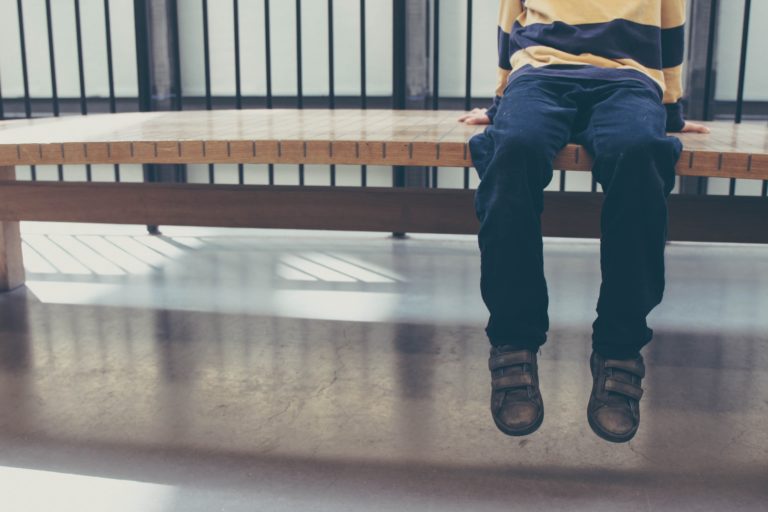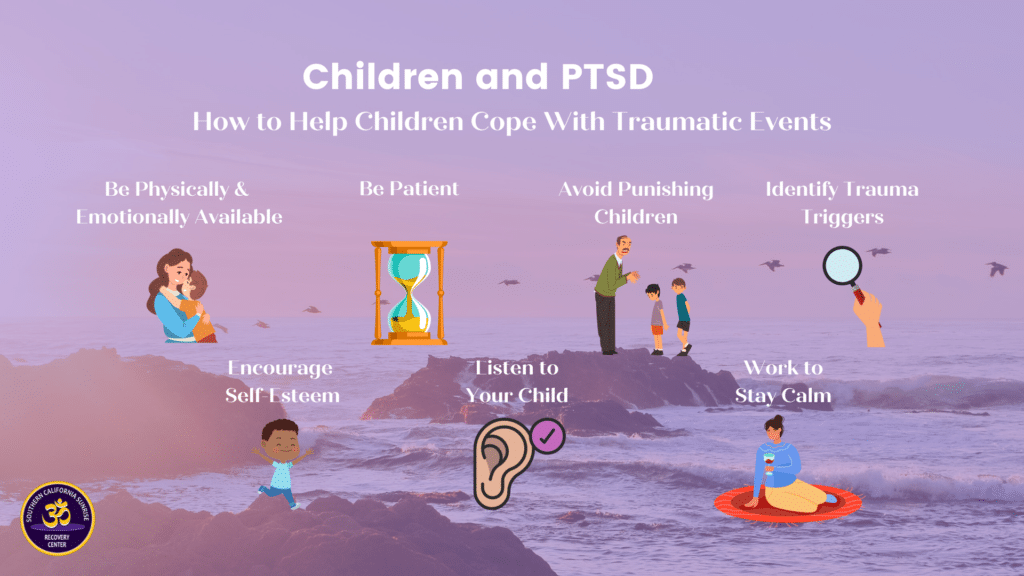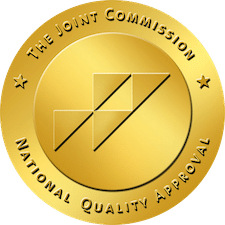It’s normal for children to experience stress in their lives in one way or another. Most of the time, children can recover quickly but other times the stress can be severe and hard to overcome. This severe stress can develop into PTSD and later lead to a number of mental health issues.

Children and PTSD: How to Help Children Cope with Traumatic Events
It’s normal for children to experience stress in their lives in one way or another. Most of the time, children can recover quickly but other times the stress can be severe and hard to overcome. This severe stress can develop into PTSD and later lead to a number of mental health issues.
Table of Contents
According to the U.S. Department of Veterans Affairs, somewhere between 14% and 43% of children and teens in the U.S. experience at least one traumatic event in their lives. Of those that had experienced a trauma, between 1% and 6% of boys and 3% and 15% of girls develop posttraumatic stress disorder.
One thing that’s important to understand about children and PTSD is that not everyone who experiences trauma will develop this disorder. Trauma among children can still create other long-lasting effects that aren’t categorized as PTSD.
Are you wondering what you should know about the physical, psychological, and emotional toll that trauma can have on children?
Let’s take a look at what you need to know.
What Is Trauma?
People often think about physical injuries when they think of trauma. However, it’s important to understand that people can also experience psychological trauma after they have experienced or witnessed an event that was distressing.
Any event that causes emotional, physical, psychological, or spiritual harm can be considered a traumatic event. As a result of this experience, a person might feel extremely frightened or physically threatened.
People can experience trauma from natural disasters such as earthquakes, hurricanes, and floods. Trauma can also be caused by acts of violence such as being robbed or having one’s house broken into. Events such as vehicle crashes and other accidents can also lead to trauma.
The reactions that people have to trauma can occur immediately or they can be delayed. The responses that somebody has to trauma can include a wide range of responses and behaviors and can differ in severity.
In some instances, an individual might not know how they should respond to a dramatic event. They also might be in denial about the fact that the event had a negative impact on them.
Basically, trauma is an emotional response to an event that either causes or threatens to cause harm. The harm can be real or perceived, physical or emotional. People can become traumatized by multiple events over time or from one single event.
Examples of Traumatic Events Children Might Experience
There are countless different types of events that could be potentially traumatic to children.
- Neglect
- Physical, emotional, or sexual abuse
- Bullying
- Effects of poverty
- Being separated from loved ones
- Accidents or natural disasters
- Witnessing harm to a loved one or pet
- Unpredictable behavior by parents due to mental illness or addiction
- The sudden or accidental death of a friend or family member
- Acts of violence
- Accidental or natural disasters
- Suicide of someone close
- Death of a classmate or teacher
It can also be traumatic for children to be in the child welfare system. In this instance, they are separated from their home and family and can repeatedly experience separation if they have a number of different placements.
Trauma Among Children: Common Responses
When a child experiences a disturbing event of one kind or another it is normal for them to react with traumatic stress. This can trigger a wide range of physical, emotional, and behavioral reactions. Children, no matter their age, can be left feeling completely overwhelmed by stress.
A child’s appetite, mood, sleep, and well-being can be impacted by a traumatic event. Children of different ages might exhibit different signs of trauma.
- Appearing withdrawn
- Exhibiting changes in eating or sleeping patterns
- Being harder to soothe or fussing more
- Clinging more to the parent or caregiver
- Showing signs of fear
- Whining, crying, or screaming
- Regressing to behaviors from earlier childhood, such as bedwetting or thumbsucking
- Freezing up or moving aimlessly
- Experiencing sleep problems, including nightmares
- Losing interest in family, friends, or activities they once enjoyed
- Struggling with homework and school
- Becoming disruptive, moody, or angry
- Developing unfounded fears
- Complaining of physical problems such as stomachaches or headaches
- Feeling depressed, guilty, or emotionally numb regarding the event
- Acting disrespectful, disruptive, or aggressive
- Complaining of physical ailments
- Suffering from nightmares, having flashbacks of the event, or experiencing sleep problems
- Avoiding being reminded of the event
- Feeling guilty, depressed, or isolated
- Having suicidal thoughts
- Abusing drugs, alcohol, or nicotine
- Losing interest in hobbies and other things they once enjoyed
It is important to offer extra support and reassurance after a traumatic event matter how old your child is. When you offer them guidance and love, it can help them to process the traumatic event and allow the feelings of traumatic stress to fade away.
The Effects of Traumatic Events on Children
Trauma can impact your child’s physical health, brain function, behavior, and emotions. Let’s take a look at some of the effects of trauma on children.
Physical Health
Trauma might affect children’s bodies in a number of ways. These include being unable to control their physical responses to stress as well as developing chronic illness. The effects of trauma can even lead to chronic illnesses into adulthood such as obesity and heart disease.
Brain Function
Trauma can also have an impact on the cognitive function of a child. Experiencing, can make it difficult to concentrate, thanks, and learn. It can also impair a child’s memory.
Trauma can also make it so it is difficult for a child or adolescent to switch from one activity or thought to another.
Behavior
Children can be impacted behaviorally by trauma in a number of different ways. It might leave them to abuse substances or to lack impulse control. They also might begin to exhibit behaviors such as aggression, fighting, and running away.
Another behavioral effect of experiencing trauma for a child or teenager is a risk of suicide.
Emotions
Experiencing trauma can be very difficult emotionally for children and leave long-lasting effects.
Some of the ways that trauma might affect children include:
- Feeling unsafe
- Difficulty forming attachments to caregivers
- Low self-esteem
- Anxiety and depression
- Trust issues
- Inability to regulate emotion
- Trouble with friendships
In the next section, we will discuss the impact it can have on children for trauma to go untreated.
The Impact of Untreated Trauma
It is generally understood that children are quite resilient. Experiencing some stress can actually help them develop new skills and help their brains grow. Examples of this type of stress include riding a bike for the first time, leaving parents for a day at school, and feeling nervous before a performance or game.
Some events, though, overwhelm a child’s natural ability to cope. These events are traumatic by definition. When a stressful experience is too much for a child to handle, their body responds with a “fight, flight, or freeze” response which can change both the body and the brain.
In a lot of instances, children can actually recover quite quickly from a potentially traumatic experience both physiologically and cognitively. In these cases, there might not be any lasting harm at all. For some kids, though, experiencing a traumatic event can have long-lasting effects and interfere with normal development.
There are four specific symptoms that point to the presence of posttraumatic stress disorder (PTSD) in children and adults.
#1
Avoidance (reminders about the event and distressing memories)
#2
Remembering/re-experiencing (flashbacks or nightmares)
#3
Alterations in arousal (persistnet sleep distruabnce, reckless behavior)
#4
Negative mood and cognitions (persistent negative beliefs, feeling alienated)
Even if a child doesn’t have all of the symptoms of PTSD, that doesn’t mean they haven’t been impacted by the trauma they experienced.
What Are the Different Factors That Influence the Impact of Traumatic Events on Children?
There are a number of different factors that influence the type of impact that a stressful and traumatic event can have on a child. These include age, frequency, relationships, coping skills, perception, and sensitivity.
Age
In general, children are more vulnerable to traumatic events the younger they are. Even children that can’t yet talk can retain “sense memories” of traumatic events. The effects of these events can impact their well-being even into adulthood.
Frequency
It is more harmful for a child to experience multiple types of traumatic events or several instances of the same type of traumatic event than it is for them to experience a single event. When a child has been exposed to multiple traumatic events it can lead to what is known as complex trauma.
Relationships
The relationships that a child has with a parent or other loved ones impacts how quickly they recover from a traumatic event if at all. When kids have positive relationships with the people around them and supportive caregivers they are much more likely to recover.
Coping Skills
All children are different, and some of them have more advanced coping skills than others. When a child is physically healthy, intelligent, and has healthy self-esteem, it can help them to cope with trauma.
Perception
One important factor that impacts how trauma affects a child is their perception. The amount of fear they feel or how much danger they think they’re in is a major factor.
Sensitivity
Some children are simply naturally more sensitive than others. It’s important to understand that each child is different and that two children of the same age might react quite differently to the same event.
What You Can Do to Help Your Child Cope With Trauma
Children can recover from trauma when they have caring and supportive adults to help them.
- Identify things that are trauma triggers for your child and help them avoid these triggers until they have reached a healthy level of healing
- Be both physically and emotionally available
- Work to stay calm when you’re child is upset
- Don’t take their behavior personally
- Avoid punishing children physically
- Help your child learn to relax
- Listen to your child and don’t avoid uncomfortable conversations or difficult topics
- Be predictable and consistent
- Encourage your child to have a sense of control over their life in an age-appropriate way
- Be patient and understand that recovery doesn’t occur overnight
- Encourage self-esteem to help children increase resilience and recover from trauma
When a child’s symptoms of traumatic stress last for more than several weeks or if it seems that they are getting worse rather than healing, you might want to look into treatment options. A professional therapist might be able to help both you and your child.
(Check out this article with seven key signs of emotional trauma.)
Children and PTSD: Treatment Options
The treatment options for PTSD in children are the same as those for adults. Both medication and cognitive-behavioral therapy (CBT) can help children who suffer from PTSD. Kids, however, need extra support and care from their parents, friends, and teachers in order to be able to feel safe and comfortable again.
Some other treatments used for PTSD include Eye Movement Desensitization and Reprocessing, Exposure Therapy, and Acceptance and Commitment Therapy.
(Interested in learning more about PTSD? Check out this article about PTSD and narcissistic abuse.)
PTSD In Children: Are You Searching For Help in California?
When you are researching children and PTSD, one of the most common themes you will discover is just how important a strong support system is for a child’s recovery. While parents, family, friends, and community are able to provide this in some instances, sometimes it is necessary to incorporate a team of professionals.
Are you looking for help and resources to support your child that is coping with trauma? Consider contacting our recovery center to learn more about our program.
References
- Child regression: What it is and how you can support your little one. (n.d.). Retrieved from https://www.unicef.org/parenting/child-development/what-is-childhood-regression
- Children and Trauma: Update for Mental Health Professionals. (n.d.). Retrieved from https://www.apa.org/pi/families/resources/children-trauma-update
- Child Welfare Information Gateway. (2020). The importance of a trauma-informed child welfare system. Washington, DC: U.S. Department of Health and Human Services, Administration for Children and Families, Children’s Bureau. Retrieved from https://www.childwelfare.gov/pubpdfs/trauma_informed.pdf
- Khoury, L., Tang, Y. L., Bradley, B., Cubells, J. F., & Ressler, K. J. (2010, December). Substance use, childhood traumatic experience, and Posttraumatic Stress Disorder in an urban civilian population. Retrieved from https://www.ncbi.nlm.nih.gov/labs/pmc/articles/PMC3051362/
- Peterson, S. (2018, June 11). Effects. Retrieved from https://www.nctsn.org/what-is-child-trauma/trauma-types/complex-trauma/effects
- Peterson, S. (2018, May 25). Disasters. Retrieved from https://www.nctsn.org/what-is-child-trauma/trauma-types/disasters
- Peterson, S. (2018, November 05). About Child Trauma. Retrieved from https://www.nctsn.org/what-is-child-trauma/about-child-trauma
- Post-traumatic stress disorder (PTSD). (2018, July 06). Retrieved from https://www.mayoclinic.org/diseases-conditions/post-traumatic-stress-disorder/symptoms-causes/syc-20355967
- Recognizing and Treating Child Traumatic Stress. (n.d.). Retrieved from https://www.samhsa.gov/child-trauma/recognizing-and-treating-child-traumatic-stress

